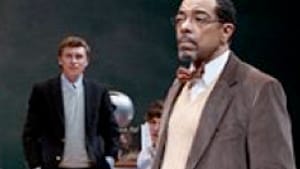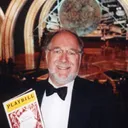Stay in the Loop
BSR publishes on a weekly schedule, with an email newsletter every Wednesday and Thursday morning. There’s no paywall, and subscribing is always free.
Is there an acoustician in the house?
"The History Boys' at the Arden (2nd review)

Alan Bennett's The History Boys, set in a second-tier British boarding school, is a witty play about the value of education and a paean to the joys of language. Yes, it's ramshackle, with scenes that may seem extraneous, but this slapdash quality makes Bennett's point that learning shouldn't be reduced to neat formulas.
Hector wants his students to become well-rounded human beings. His subject is history, but Hector teaches his students the French subjunctive, reads them poetry and has them re-enact scenes from movies. In the Arden production, Frank X notably demonstrates that you can play a convincing Hector without being round-faced and white-haired like Richard Griffiths, who seemed to own the role in London, New York and in the film version.
The History Boys takes a long three hours, and it could be shortened by eliminating the framing scenes that take place years later, or by trimming a scene spoken in French. I, however, enjoy seeing Alan Bennett's creation in its entirety. And hearing it in its entirety. I wouldn't want to miss a word. And there's the rub.
A problem of acoustics
The Arden's current production uses a thrust stage with no proscenium to focus the actors' voices and direct them toward the audience. In addition, action often plays to the sides and the rear, causing words to be lost.
This is especially disappointing because director Terrence Nolen and his staff have devoted considerable attention to getting accents correct and distinct. Some of this good work was canceled out by the stage configuration. A woman seated next to me, who came from Yorkshire, where the play is set, said she had no problem with the dialect but did have trouble hearing the words. So at intermission she got a listening device, which management provides for those who ask. I followed her cue, and we found ourselves in a line of like-minded patrons.
These earphones, it turns out, are easy to control. The sound is picked up by microphones on the stage's periphery. When you see actors move upstage and their voices get faint, you just rotate a dial to increase the volume.
A possible solution
When The History Boys played in London, it was presented at the smallish, 890-seat Lyttelton, which has a traditional proscenium. In New York the venue was the slightly larger Broadhurst (where Hamlet now is playing), which also has a proscenium. There, the three sides of the stage helped to bounce the sound out to the audience. The Arden's mainstage, by contrast, seats only 360. In such an intimate space, must theatergoers affix electronic gadgets to their heads in order to understand the dialogue?
A solution might be to use body microphones for plays with thrust staging. Such mikes are routinely used with musicals, but not with straight plays. I would argue that it's even more important to amplify the dialogue of a spoken play than it is to amplify singing.
Nolen's choreographic style
Beyond the sound issue, this production provides much pleasure. One factor overlooked by other reviews is Nolen's choreographic style of direction. The play has numerous set pieces, and the prep school students frequently move in captivating, dance-like formations, even during non-musical scenes. Nolen astutely surmised that playwright Bennett was aiming for entertainment, almost for a variety show. Bennett, you'll recall, became famous in the "'60s as one of the writers and performers of Beyond the Fringe, in which such free spirits as Peter Cook, Dudley Moore and Jonathan Miller mixed erudition and songs in a frontal assault on sanctimony.
The History Boys advocates a liberal cultural education, which has become an endangered species in this age of specialization. I received such an education back in the '50s as a member of the 197th class at The Central High School of Philadelphia. Note that Central students refer to their numerical place in the school's history, rather than their year of graduation, as other schools do. Also note that the correct title of the institution includes the prepositional "the." When established in 1838 Central was, in fact, America's first public high school outside New England, and it later opened branches in the Northeast and West Philadelphia and Germantown that eventually were given independent status.
Another anomaly about Central is that it is administered by a president— as at a college— rather than a principal. When I matriculated it was, like the school in The History Boys, for boys only. We had to rise when the president entered a room. In a democratic gesture, President William Hafner Cornog ended that century-old custom. We still, however, knew to fall respectfully silent in his presence. Although Central had few instructors as colorful as Hector in The History Boys, it did inculcate us with an intense education and with the belief that culture and erudition are cool.
That helped make this production even more meaningful for me.♦
To read another review by Jim Rutter, click here.
Hector wants his students to become well-rounded human beings. His subject is history, but Hector teaches his students the French subjunctive, reads them poetry and has them re-enact scenes from movies. In the Arden production, Frank X notably demonstrates that you can play a convincing Hector without being round-faced and white-haired like Richard Griffiths, who seemed to own the role in London, New York and in the film version.
The History Boys takes a long three hours, and it could be shortened by eliminating the framing scenes that take place years later, or by trimming a scene spoken in French. I, however, enjoy seeing Alan Bennett's creation in its entirety. And hearing it in its entirety. I wouldn't want to miss a word. And there's the rub.
A problem of acoustics
The Arden's current production uses a thrust stage with no proscenium to focus the actors' voices and direct them toward the audience. In addition, action often plays to the sides and the rear, causing words to be lost.
This is especially disappointing because director Terrence Nolen and his staff have devoted considerable attention to getting accents correct and distinct. Some of this good work was canceled out by the stage configuration. A woman seated next to me, who came from Yorkshire, where the play is set, said she had no problem with the dialect but did have trouble hearing the words. So at intermission she got a listening device, which management provides for those who ask. I followed her cue, and we found ourselves in a line of like-minded patrons.
These earphones, it turns out, are easy to control. The sound is picked up by microphones on the stage's periphery. When you see actors move upstage and their voices get faint, you just rotate a dial to increase the volume.
A possible solution
When The History Boys played in London, it was presented at the smallish, 890-seat Lyttelton, which has a traditional proscenium. In New York the venue was the slightly larger Broadhurst (where Hamlet now is playing), which also has a proscenium. There, the three sides of the stage helped to bounce the sound out to the audience. The Arden's mainstage, by contrast, seats only 360. In such an intimate space, must theatergoers affix electronic gadgets to their heads in order to understand the dialogue?
A solution might be to use body microphones for plays with thrust staging. Such mikes are routinely used with musicals, but not with straight plays. I would argue that it's even more important to amplify the dialogue of a spoken play than it is to amplify singing.
Nolen's choreographic style
Beyond the sound issue, this production provides much pleasure. One factor overlooked by other reviews is Nolen's choreographic style of direction. The play has numerous set pieces, and the prep school students frequently move in captivating, dance-like formations, even during non-musical scenes. Nolen astutely surmised that playwright Bennett was aiming for entertainment, almost for a variety show. Bennett, you'll recall, became famous in the "'60s as one of the writers and performers of Beyond the Fringe, in which such free spirits as Peter Cook, Dudley Moore and Jonathan Miller mixed erudition and songs in a frontal assault on sanctimony.
The History Boys advocates a liberal cultural education, which has become an endangered species in this age of specialization. I received such an education back in the '50s as a member of the 197th class at The Central High School of Philadelphia. Note that Central students refer to their numerical place in the school's history, rather than their year of graduation, as other schools do. Also note that the correct title of the institution includes the prepositional "the." When established in 1838 Central was, in fact, America's first public high school outside New England, and it later opened branches in the Northeast and West Philadelphia and Germantown that eventually were given independent status.
Another anomaly about Central is that it is administered by a president— as at a college— rather than a principal. When I matriculated it was, like the school in The History Boys, for boys only. We had to rise when the president entered a room. In a democratic gesture, President William Hafner Cornog ended that century-old custom. We still, however, knew to fall respectfully silent in his presence. Although Central had few instructors as colorful as Hector in The History Boys, it did inculcate us with an intense education and with the belief that culture and erudition are cool.
That helped make this production even more meaningful for me.♦
To read another review by Jim Rutter, click here.
What, When, Where
The History Boys. By Alan Bennett; Terrence J. Nolen directed. Through Nov. 1, 2009 at the Arden Theatre, 40 N. Second St. (215) 922-1122 or www.ardentheatre.org.
Sign up for our newsletter
All of the week's new articles, all in one place. Sign up for the free weekly BSR newsletters, and don't miss a conversation.

 Steve Cohen
Steve Cohen